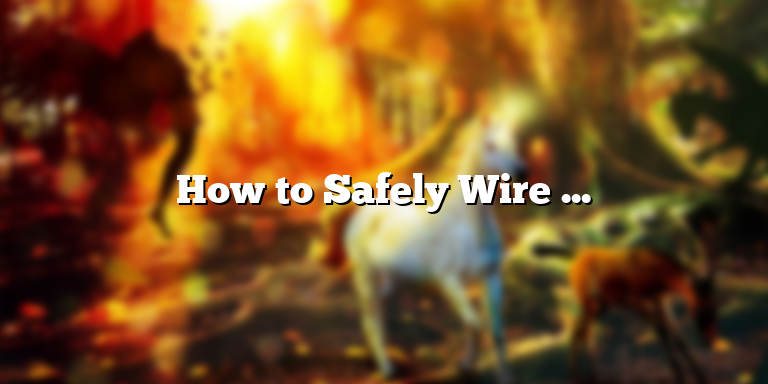
Identifying the Sounds
Hearing noises from within your walls can be a concerning and perplexing experience. Not only can animal intrusions damage your property, but some pests can also pose a risk to your health. Identifying the type of animal making the noise in your wall is crucial to finding a solution to the problem. Here are some common sounds that different animals make inside walls that will help you identify what’s lurking inside:
Rodents
Rodents are one of the most common animals that can invade homes and get inside walls. They usually make a noise that sounds like scurrying or scratching. Rats and mice have distinctive paw sounds that are often recognizable. If you hear squeaking or chattering, it is most likely little mice that are seeking to make themselves at home. When rodents gnaw, stuck in the wall or in the attic, the sound has a distinct and persistent grinding noise.
Birds
Birds can also make their way into homes and cause noises in walls. Most often, the sound will be soft chirping or tweet-like sounds. If the chirping is loud and continuous, the creature is likely a nest with baby chicks nesting in it. Meanwhile, a fluttering noise could indicate that a bird is inside your wall.
Insects
Although insects are tiny, their sound can be unmistakable up the walls of your house. Insects like bees can buzz loudly inside walls when they are locked in. Termites make a soft scraping noise that can be heard if you move around near the spot they are located. Likewise, hornets or wasps may make a rustling and buzzing sound inside the walls.
Squirrels
If you hear loud, scratching or scurrying sounds coming from your wall or ceiling, it may be squirrels. These critters are known for causing a ruckus and will try to climb anything, even the exterior of your house, and the roof to penetrate the wall. They are likely to make noise during daylight hours and can be very active in the morning and late afternoon.
Raccoons
Raccoons are sneaky creatures that can also make their way into homes and wreak havoc in the walls. Often, they will make a distinct thumping or thudding sound when they are moving about. This could result from small scratches and light shuffling or jerky movements.
Opossums
Opossum sounds are very strange to hear inside walls, as they often make guttural and low sounds that are unlike other animals. They “plays dead” and emit a foul odor, which can be harmful, so if you hear this kind of sound coming from your walls, call a professional wildlife removal service right away.
It’s important to remember that each species of animal has a unique sound that it makes inside walls. If you can identify the type of animal causing the noise, you will be more equipped to take the right steps to remove it safely and protect your property against future infestations.
Checking for Animal Droppings
Animal droppings are a telltale sign of an unwanted animal residing in your wall. Often, animals will leave droppings around the base of the wall or on the floor beneath the wall. The appearance of the droppings can provide clues as to what type of animal is living in your wall.
Rodents such as rats and mice will leave small, cylindrical droppings, typically about the size of a grain of rice. Squirrels and raccoons, on the other hand, will leave larger droppings that are more rounded in shape.
If you are unsure whether or not the droppings are from an animal or not, you can perform a simple test. Sprinkle flour around the area where you suspect the animal is entering and exit. Check the flour for animal footprints or scat. This will help you confirm the presence of an animal and provide more detailed information about the type of animal living in your wall.
If you do find animal droppings, it is important to take action immediately. Animal droppings can carry harmful bacteria and viruses, which can pose health risks to you and your family. It is important to clean up the droppings and sanitize the affected area thoroughly.
Once you have confirmed the presence of an animal in your wall, it is best to contact a professional animal removal service. Attempting to remove the animal on your own can be dangerous and may result in the animal becoming trapped or injured. A professional animal removal service has the experience and equipment necessary to safely and humanely remove the animal from your wall.
It is also important to identify and repair the area of your wall in which the animal is entering. Failure to do so will result in another animal taking up residence in your wall. A professional animal removal service can provide advice on how to prevent animals from entering your home in the future.
In conclusion, checking for animal droppings is an effective way to identify the presence of an animal in your wall. If you do find droppings, it is important to take action immediately to ensure the health and safety of you and your family. Contacting a professional animal removal service is your best option for safely and humanely removing the animal from your wall and preventing future infestations.
Spotting Entry Points
If you hear rustling or scratching sounds coming from within your walls, it’s likely that you have an animal living inside. There are several signs to look for to determine exactly where the entry points for these creatures are located. Animals can enter your property through holes or cracks in the walls, foundation, or roof of your home. The best way to find the entry points is to take a thorough look around the exterior of your house.
Start by inspecting the foundation of your home. Make sure to check for any cracks or gaps in the mortar, bricks, or siding. Use a flashlight to look for any holes that could be used as entry points. If you find any, fill them immediately with caulking or metal screens, as animals like rats and squirrels can easily chew through these barriers. Check for any missing roof shingles or vent covers. These can also be potential entry points for larger animals like raccoons.
Another place to check is your home’s gutters. Animals like mice and rats can climb through gaps in the downspouts and enter your home. Check that your downspouts are empty and free from debris, and install mesh screens to deter animals from climbing up the pipes.
It’s worth noting that some animals, like squirrels and raccoons, are excellent climbers and can easily scale your house. They may look for gaps between the roof or the chimney and the fascia board, so be sure to check those areas too. Once you’ve identified the entry points, you can take measures to seal them and prevent animals from entering your home.
It’s essential to identify the type of animal in your wall as soon as possible to avoid any further damage to your property. Once you have located the entry points, you can take action to remove the animal safely and humanely.
Remember that it’s always best to seek the help of a professional when dealing with wildlife removal. They have the knowledge and tools to remove animals safely and restore your home to its original condition.
Signs of Gnawing
One of the most telltale signs that an animal has taken up residence in your walls is the sound of persistent gnawing. Gnawing marks left behind can also help you to identify the intruder. Many animals, such as rats and mice, have teeth that grow continuously throughout their lives. As a result, these animals are compelled to constantly gnaw on objects to prevent their teeth from becoming too long. In the process, they leave behind distinctive gnaw marks on wood, plastic, and other materials.
If you suspect that the culprit is a rat, look for gnawing marks that are approximately a quarter of an inch wide. Rats tend to gnaw on electrical wires, which can cause significant damage and even lead to electrical fires. If you notice a combination of small and larger gnaw marks, it could indicate that both rats and mice have taken up residence in your walls.
On the other hand, if you notice long, continuous gnaw marks, it is likely that a squirrel is the intruder. Squirrels are known for their strong, sharp teeth and will leave long, distinct gnaw marks on wood. This is especially concerning if the animal has made its way into your attic, as squirrels can cause extensive damage to insulation and wiring.
If you spot small, evenly spaced gnawing marks that appear to be in a pattern, it may indicate that a chipmunk has made its way into your walls. These rodents are known for creating burrows in the ground, but they can also excavate tunnels into walls to create a cozy shelter. Chipmunks will often gnaw on wood or electrical wires, but their damage is usually less severe than that caused by rats or squirrels.
Conclusion
Gnawing marks can be a useful clue when trying to figure out what kind of animal has taken up residence in your walls. By identifying the size, shape, and pattern of the gnaw marks, you may be able to determine what species of animal is causing the disturbance. In any case, it is important to address the situation quickly before the animal causes additional damage or poses a health risk to you and your family.
When to Call in the Professionals
Although identifying the animal in your wall can be done with some research and detective work, there are instances when calling in a professional pest control service is the best course of action. Here are some scenarios where you should seek help from the experts:
1. You Cannot Identify the Animal
If you have exhausted all means of identifying the animal but still cannot make a positive identification, it is best to get help from a professional. Some animals can have similar sounds and behaviors, making it challenging to tell them apart. Pest control professionals have the necessary training and experience to accurately identify the type of animal in your wall and implement the right method of removal.
2. The Animal is Dangerous
If you suspect that the animal in your wall is hazardous, it is crucial to call a pest control expert immediately. Some animals can be aggressive and transmit deadly diseases. Venomous snakes, for instance, should never be handled by untrained individuals as they can strike without warning.
3. You Have Tried DIY Methods Without Success
If you have attempted to remove the animal yourself but have not been successful, it is time to call in the professionals. DIY methods such as trapping and releasing may not work for all types of animals. Additionally, some animals can cause serious damage to your property if they are not removed correctly.
4. The Animal is Trapped or Injured
If the animal is trapped or injured in your wall, never attempt to remove it yourself. Trying to extract a trapped or injured animal can cause it to become agitated and aggressive, putting you in harm’s way.
5. You’re Unsure About the Local Laws and Regulations
Some animals are protected by local laws and regulations, which may limit your ability to remove them from your property. It is vital to consult with a pest control professional who is well-versed in the local laws and regulations to avoid getting into trouble with the authorities.
Overall, calling in a professional when you suspect there is an animal in your wall can save you time, money, and help you avoid potential harm. A pest control expert has the necessary tools, equipment, and training to handle the situation in the most efficient and humane manner.






